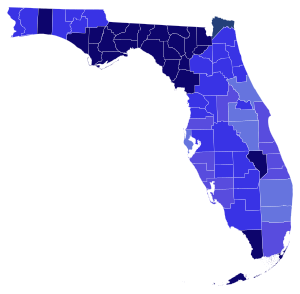
Summary
The 1944 Florida gubernatorial election was held on November 7, 1944. Democratic nominee Millard Caldwell defeated Republican nominee Bert L. Acker with 78.94% of the vote.
| |||||||||||||||||
| |||||||||||||||||
 County results Caldwell: 60–70% 70–80% 80–90% >90% | |||||||||||||||||
| |||||||||||||||||
Primary elections edit
Primary elections were held on May 2, 1944, with the Democratic runoff held on May 23, 1944.
Democratic primary edit
Candidates edit
- J. Edwin Baker, former Florida State Senator
- Millard Caldwell, former U.S. Representative for the 3rd district
- Ernest R. Graham, Florida State Senator
- Robert A. (Lex) Green, U.S. Representative for the at-large district
- Raymond Sheldon, State Senator
- Frank D. Upchurch, Florida State Senator
Results edit
- 50–60%
- 60–70%
- 70–80%
- 50–60%
- 60–70%
- 80–90%
| Party | Candidate | Votes | % | |
|---|---|---|---|---|
| Democratic | Millard F. Caldwell | 116,111 | 28.39 | |
| Democratic | Robert A. Green | 113,300 | 27.90 | |
| Democratic | Ernest R. Graham | 91,174 | 22.45 | |
| Democratic | Frank D. Upchurch | 30,524 | 7.52 | |
| Democratic | Raymond Sheldon | 27,940 | 6.88 | |
| Democratic | J. Edwin Baker | 27,028 | 6.66 | |
| Total votes | 406,077 | 100.00 | ||
| Party | Candidate | Votes | % | |
|---|---|---|---|---|
| Democratic | Millard F. Caldwell | 215,485 | 55.31 | |
| Democratic | Robert A. Green | 174,100 | 44.69 | |
| Total votes | 389,585 | 100.00 | ||
Republican primary edit
Candidates edit
- Bert L. Acker, public relations consultant,[5] unsuccessful candidate for Florida's 4th US Congressional district in 1940 and 1942.[6]
- Edward T. Keenan
Results edit
| Party | Candidate | Votes | % | |
|---|---|---|---|---|
| Republican | Bert L. Acker | 5,954 | 61.26 | |
| Republican | Edward T. Keenan | 3,766 | 38.75 | |
| Total votes | 9,720 | 100.00 | ||
General election edit
Bert Acker who ran as a Republican, would be against the New Deal in his campaign. He also wanted to eliminate laws he thought were useless and conflicting. Acker was in favor of leasing lands owned by the state government to be used by farmers and cattle ranchers. Acker wanted to allow mining and oil production to be done on state owned lands as well. Acker wanted to see the sugar industry in the state expanded as well. Acker was against taxes that were created as a result of World War II in the state and wanted to exempt homes that were valued at $15,000 from state taxes. In terms of infrastructure, he supported expanding the state highway system and widening roads physically themselves along with improving safety on bridges.[8]
Candidates edit
- Millard Caldwell, Democratic
- Bert Acker, Republican
Results edit
| Party | Candidate | Votes | % | ±% | |
|---|---|---|---|---|---|
| Democratic | Millard F. Caldwell | 361,007 | 78.94% | ||
| Republican | Bert L. Acker | 96,321 | 21.06% | ||
| Majority | 264,686 | 57.88% | |||
| Turnout | 457,328 | 100.00% | |||
| Democratic hold | Swing | ||||
References edit
- ^ "FL Governor, 1944 - D Primary". Our Campaigns. Retrieved April 6, 2020.
- ^ a b Florida Handbook 1965-66, p. 364.
- ^ a b c Congressional Quarterly 1998, p. 105.
- ^ "FL Governor, 1944 - D Runoff". Our Campaigns. Retrieved April 6, 2020.
- ^ "These Candidates For Governor Will Appear On Tuesday's Primary Ballot". The Miami News. May 2, 1948. Retrieved September 5, 2021 – via Newspapers.com.
- ^ "Our Campaigns - Candidate - Bert L. Acker". www.ourcampaigns.com. Retrieved September 5, 2021.
- ^ "FL Governor, 1944 - R Primary". Our Campaigns. Retrieved April 6, 2020.
- ^ "Acker Visits City on GOP Vote Tour". Orlando Evening Star. October 24, 1944. Retrieved July 25, 2021 – via Newspapers.com.
- ^ "FL Governor, 1944". Our Campaigns. Retrieved April 6, 2020.
- ^ Florida Handbook 1965-66, p. 372.
- ^ Glashan 1979, pp. 58–59.
- ^ Congressional Quarterly 1998, p. 47.
Bibliography edit
- Morris, Allen (1965). The Florida Handbook, 1965-66. Tallahassee, FL: The Peninsular Publishing Company.
- Glashan, Roy R. (1979). American Governors and Gubernatorial Elections, 1775-1978. Meckler Books. ISBN 0-930466-17-9.
- Gubernatorial Elections, 1787-1997. Washington, D.C.: Congressional Quarterly Inc. 1998. ISBN 1-56802-396-0.




